Rockwell Kent, though best known as an artist and illustrator, pursued many careers throughout his long life, including architect, carpenter, explorer, writer, dairy farmer, and political activist. Born in Tarrytown, New York, Kent was interested in art from a young age. Kent attended the Horace Mann School in New York City, where he excelled at mechanical drawing. His family’s financial circumstances prevented him from pursuing career in the fine arts, however, and after graduating from Horace Mann in 1900, Kent decided to study architecture at Columbia University.
Before matriculating at Columbia, Kent spent the first of three consecutive summers studying painting at William Merritt Chase's art school in Shinnecock Hills, Long Island. There he found a community of mentors and fellow students who encouraged him to pursue his interest in art. At the end of Kent’s third summer at Shinnecock, Chase offered him a full scholarship to the New York School of Art, where he was a teacher. Kent began taking night classes at the art school in addition to his architecture studies, but soon left Columbia to study painting full time.
Kent spent the summer of 1903 assisting the painter Abbott Handerson Thayer at his studio in Dublin, New Hampshire—a position he secured through the recommendation of his Aunt Jo. Thayer gave the young artist time to pursue his own work, and that summer Kent painted several views of the New Hampshire landscape, including Mount Monadnock. In 1905 Kent moved from New York to Monhegan Island in Maine, home to a summer art colony, where he continued to find inspiration in the natural world. Kent soon found success exhibiting and selling his paintings in New York and in 1907 was given his first solo show at Claussen Galleries.
For the next several decades, Kent lived a peripatetic lifestyle, settling in several locations in Connecticut, Maine, and New York. During this time he took a number of extended voyages to remote, often ice-filled, corners of the globe, including Newfoundland, Alaska, Tierra del Fuego, and Greenland, to which he made three separate trips. For Kent, exploration and artistic production were twinned endeavors, and his travels to these rugged, rural locales provided inspiration for both his visual art and his writings. He developed a stark, realist landscape style in his paintings and drawings that revealed both nature’s harshness and its sublimity. Kent’s human figures, which appear sparingly in his work, often signify mythic themes, such as heroism, loneliness, and individualism. Important exhibitions of works from these travels include the Knoedler Gallery’s shows in 1919 and 1920, featuring Kent’s Alaska drawings and paintings, and the Art Institute of Chicago’s 1933 Paintings and Drawings of Greenland by Rockwell Kent. He wrote a number of illustrated memoirs about his adventures abroad, including Wilderness: A Journal of Quiet Adventure in Alaska (1920) and N by E (1930). His autobiography, It’s Me, O Lord, was published in 1955.
Around 1920 Kent took up wood engraving and quickly established himself as one of the preeminent graphic artists of his time. His striking illustrations for two editions of Herman Melville’s Moby Dick—simultaneously precise and abstract images that drew on his architect’s eye for spatial relations and his years of maritime adventures—proved extremely popular and remain some of his best-known works. Throughout the 1920s and 1930s, Kent produced a range of print media, including advertisements, bookplates, and Christmas cards. Kent’s satirical drawings, created under the pseudonym “Hogarth Jr.,” were published in popular periodicals including Vanity Fair, Harper’s Weekly, and Life. In 1937 the artist was commissioned by the Federal Public Works Administration to paint two murals for the New Post Office in Washington, DC.
By the onset of World War II, Kent had largely disengaged from the New York art world and instead focused his energies on a number of progressive political causes, including labor rights and preventing the spread of fascism in Europe. Though he never joined the communist party, his support of leftist causes made him a target of suspicion by the State Department, which revoked his passport after his first visit to Moscow in 1950 (though Kent successfully sued to have it reinstated). As his artistic reputation declined at home and his work fell out of favor, Kent found new popularity in the Soviet Union, where his works were exhibited frequently in the 1950s. In 1960 he donated 80 paintings and 800 prints and drawings to the people of the Soviet Union, and in 1967 he was awarded the Lenin Peace Prize. Kent died of a heart attack in 1971 and was buried on the grounds of Asgard, his farm in New York’s Adirondack Mountains.
Biography by Zoë Samels
National Gallery of Art, Washington DC
This is part 1 of a 16-part series on the works of Rockwell Kent:
 |
| 1903 Dublin Pond oil on canvas 71.1 x 76.2 cm Art Museum of the Ministry of foreign Affairs, Amherst |
 |
| 1903 The Landscape of New England oil on canvas 71.1 x 76.8 cm Art Museum College Dartmouth, Hanover |
 |
| c1903 Untitled oil on wood cigar box 13.3 x 21 cm Five Colleges and Historic Deerfield Museum Consortium, MA |
 |
| c1903 Untitled oil on wood cigar box 15 x 16.5 cm Five Colleges and Historic Deerfield Museum Consortium, MA |
 |
| 1906 Cape Man, Winter oil on canvas laid down on plywood 86 x 112 cm The State Hermitage Museum, St Petersburg, Russia |
 |
| 1906 Monhegan brush and black ink on paper 13 x 14.6 cm |
 |
| 1906-07 Late Afternoon, Monhegan Island oil on canvas 87 x 110.5 cm |
 |
| 1907 Fishermen's Beach, Monhegan oil on canvas 63.8 x 76.5 cm Orlando Museum of Art, Florida |
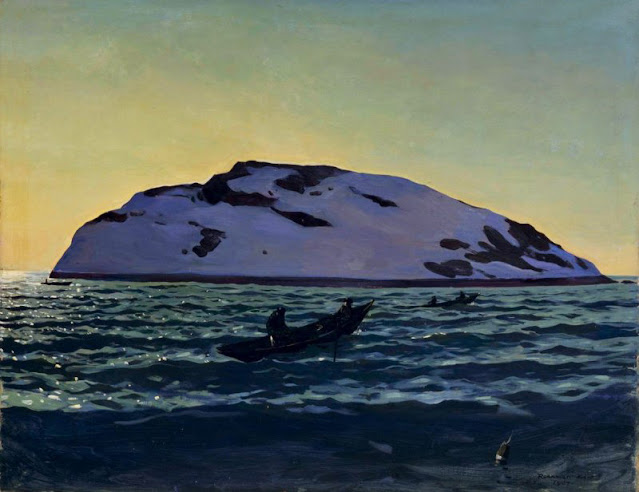 |
| 1907 Noon on the sea, Monhegan oil on canvas 86.4 x 111.8 cm Museum of Fine Arts, San Francisco, CA |
 |
| 1907 Sun, Manana, Monhegan oil on canvas 50.8 x 61 cm Museum of Art at Bowdoin College, Brunswick |
 |
| 1907 Sunset over the Sea oil on panel 19 x 21.5 cm |
 |
| 1907 The Coast of Maine oil on canvas 86.7 x 112.1 cm The Cleveland Museum of Art, Ohio |
 |
| 1907 Winter on the Coast of Maine oil on canvas 71.4 x 96.5 cm Private Collection |
 |
| 1907 Toilers of the Sea oil on canvas 96.5 x 111.8 cm Museum of American Art, New Britain |
 |
| 1907 Winter, Monhegan Island oil on canvas 86 x 111.8 cm The Metropolitan Museum of Art, New York © Estate of Rockwell Kent |
 |
| c1907 Cranberrying, Monhegan oil on canvas Terra Foundation for American Art, Chicago, IL |
 |
| 1908 Spring Fever, the Berkshire Hills, Massachusetts oil on canvas laid down on plywood 71 x 111.5 cm The Pushkin State Museum of Fine Arts, Moscow |
%20Philadelphia%20Museum%20of%20Art,%20PA%20%C2%A9%20Plattsburgh%20State%20Art%20Museum,%20State%20University%20of%20New%20York,%20USA.jpg) |
| 1908-09 Trying to Elevate the Poor brush, pen and ink on off-white wove paper 22.5 x 16.8 cm (image) Philadelphia Museum of Art, PA © Plattsburgh State Art Museum, State University of New York, USA |
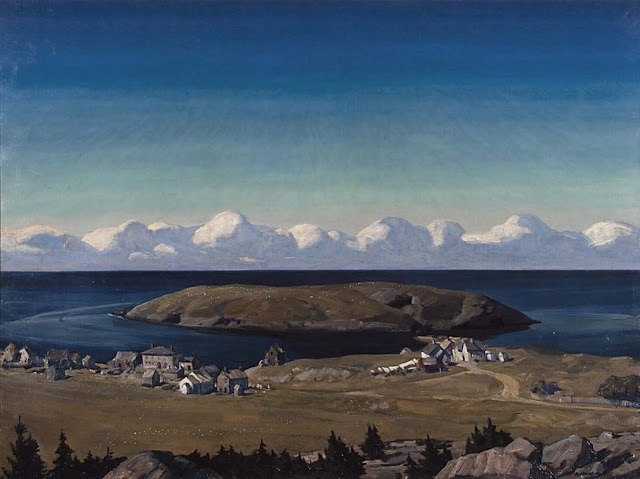 |
| 1909 A Village on the Island, Maine Coast oil on canvas 107 x 142 cm The State Hermitage Museum, St Petersburg, Russia |
 |
| 1909 Blackhead Monhegan Island, Maine oil on canvas 86.3 x 111.7 cm Colby College Museum of Art |
 |
| 1909 Blue Bay oil on panel 14.3 x 17.1 cm |
 |
| 1909 Fishermen oil on canvas 96.5 x 111.8 cm Private Collection |
 |
| 1909 Men and Mountains oil on canvas 83.8 x 109.8 cm Museum of Fine Arts, Columbus |
 |
| 1909 Mount Monadnock in the Afternoon oil on canvas 86.4 x 111.8 cm Art Museum Fansworth, Rockland |
 |
| 1909 Winter Landscape oil on canvas 96.5 x 111.7 cm Art Museum, Indianapolis |
 |
| 1909 The Road Roller oil on canvas 86.7 x 112.4 cm The Phillips Collection, Washington, DC |
 |
| 1909 The Coast of Maine, Winter oil on canvas 96.2 x 113.3 cm Museum of Fine Arts, Boston, MA |
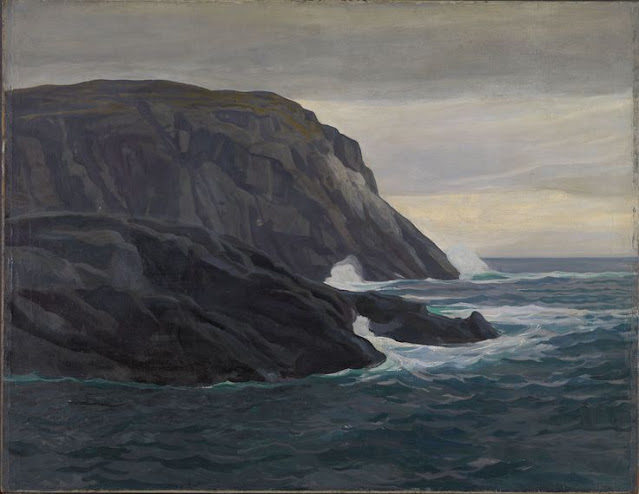 |
| 1909 The Cape Black, Monhegan oil on canvas 86.4 x 111.7 cm Museum of Art, Colby College, Waterville |
 |
| 1909 Snow Squalls oil on canvas 38.1 x 44.1 cm |
 |
| 1909 Snow Fields, Winter in the Berkshires oil on canvas 96.5 x 11.7 cm Smithsonian American Art Museum |
 |
| 1909 Peace and Freedom, Maine Coast oil on canvas 72 x 112 cm |
 |
| 1910 Down to the Sea oil on canvas 108 x 142.9 cm Brooklyn Museum, NY |
 |
| 1910 Lying in the Flames woodcut 20.3 x 14 cm Smithsonian Museum of American Art, Washington, DC |
 |
| 1910 The Mountains and the Sea oil on canvas 96.5 x 111.7 cm Private Collection |
%20Philadelphia%20Museum%20of%20Art,%20PA%20%C2%A9%20Plattsburgh%20State%20Art%20Museum,%20State%20University%20of%20New%20York,%20USA.jpg) |
| 1912-13 Angel photomechanical metal relief print 7.3 x 8.9 cm (image) Philadelphia Museum of Art, PA © Plattsburgh State Art Museum, State University of New York, USA |
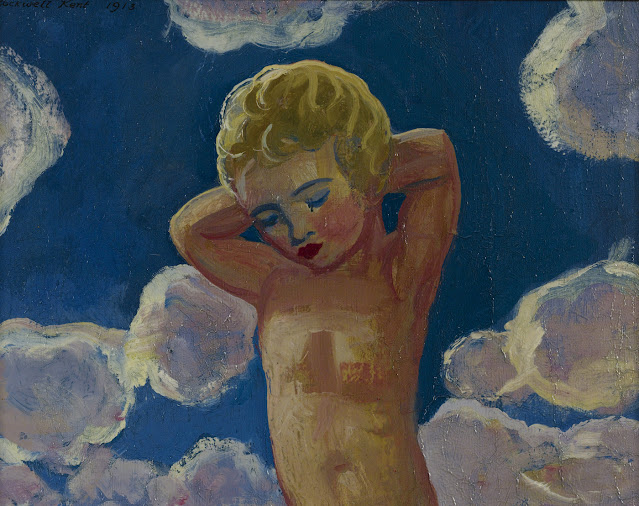 |
| 1913 Child oil on canvas laid down on panel 19.4 x 25.4 cm Private Collection |
%20Philadelphia%20Museum%20of%20Art,%20PA%20%C2%A9%20Plattsburgh%20State%20Art%20Museum,%20State%20University%20of%20New%20York,%20USA.jpg) |
| c1913 The Open Road relief print bookplate 4.9 4 cm (image) Philadelphia Museum of Art, PA © Plattsburgh State Art Museum, State University of New York, USA |
 |
| 1914 Adam Style for The Brickbuilder 1 January 1915 photomechanical print 18.1 x 12.1 cm Philadelphia Museum of Art, PA © Plattsburgh State Art Museum, State University of New York, USA |
 |
| 1914 Pastoral oil on canvas 83.8 x 110.5 cm Columbus Museum of Art, Ohio |
%20oil%20on%20canvas%2054%20x%2072%20cm%20The%20State%20Hermitage%20Museum,%20St%20Petersburg,%20Russia.jpg) |
| 1914 Portrait of a Child (or My Daughter Clara) oil on canvas 54 x 72 cm The State Hermitage Museum, St Petersburg, Russia |
 |
| 1914 Seiners oil on canvas 87.9 x 110.5 cm Museum and Sculpture Garden Hirshhorn, Washington, DC |
 |
| c1914 Ave Maria photomechanical relief print 16.2 x 10.5 cm Philadelphia Museum of Art, PA © Plattsburgh State Art Museum, State University of New York, USA |
 |
| c1914 The Pier, Monhegan Island, Maine oil on board 25.4 x 30.5 cm |
%20Philadelphia%20Museum%20of%20Art,%20PA%20%C2%A9%20Plattsburgh%20State%20Art%20Museum,%20State%20University%20of%20New%20York,%20USA.jpg) |
| c1914 Vaster is Man than his Works brush, pen and ink on off-white wove paper 9 x 7 cm (image) Philadelphia Museum of Art, PA © Plattsburgh State Art Museum, State University of New York, USA |
 |
| 1914-15 Female Figure with Outstretched Arms pen and ink |
 |
| 1914-15 Woman and Child, Christmas Card brush, pen and ink on off-white wove paper 11.7 x 8.7 cm Philadelphia Museum of Art, PA © Plattsburgh State Art Museum, State University of New York, USA |
%20Philadelphia%20Museum%20of%20Art,%20PA%20%C2%A9%20Plattsburgh%20State%20Art%20Museum,%20State%20University%20of%20New%20York,%20USA.jpg) |
| c1914-15 And Women must Weep graphite on beige wove paper 14.9 x 15.1 cm (image) Philadelphia Museum of Art, PA © Plattsburgh State Art Museum, State University of New York, USA |
%20Philadelphia%20Museum%20of%20Art,%20PA%20%C2%A9%20Plattsburgh%20State%20Art%20Museum,%20State%20University%20of%20New%20York,%20USA.jpg) |
| c1914-15 And Women must Weep ink, brush and pen on cream wove paper 14.9 x 15.1 cm (image) Philadelphia Museum of Art, PA © Plattsburgh State Art Museum, State University of New York, USA |
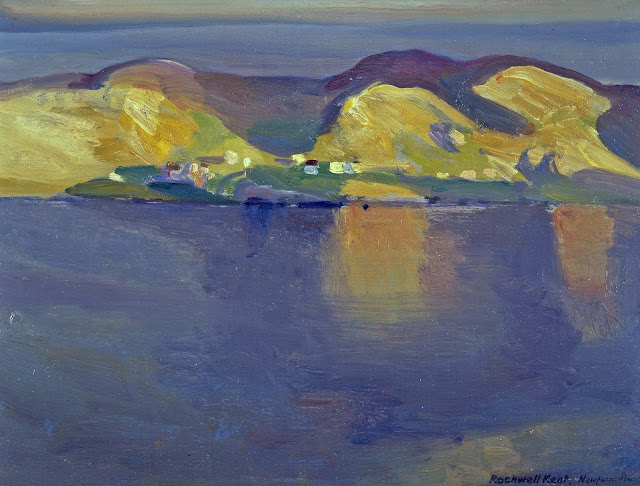 |
| 1915 Conception Bay, Newfoundland oil on panel 29.6 x 39.7 cm Bowdoin College Museum of Art |

%20Philadelphia%20Museum%20of%20Art,%20PA%20%C2%A9%20Plattsburgh%20State%20Art%20Museum,%20State%20University%20of%20New%20York,%20USA.jpg)

%20%20Philadelphia%20Museum%20of%20Art,%20PA%20%C2%A9%20Plattsburgh%20State%20Art%20Museum,%20State%20University%20of%20New%20York,%20USA%20.jpg)
%20brush%20and%20pen%20and%20black%20ink,%20with%20white%20opaque%20watercolor%20corrections,%20on%20cream%20wove%20paper32.5%20x%2025.1%20cm%20Philadelphia%20Museum%20of%20Art,%20PA%20%C2%A9%20Plattsburgh%20etc.jpg)
%20Philadelphia%20Museum%20of%20Art,%20PA%20%C2%A9%20Plattsburgh%20State%20Art%20Museum,%20State%20University%20of%20New%20York,%20USA.jpg)
%20Philadelphia%20Museum%20of%20Art,%20PA%20%C2%A9%20Plattsburgh%20State%20Art%20Museum,%20State%20University%20of%20New%20York,%20USA.jpg)


%20Philadelphia%20Museum%20of%20Art,%20PA%20%C2%A9%20Plattsburgh%20State%20Art%20Museum,%20State%20University%20of%20New%20York,%20USA.jpg)